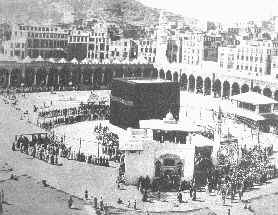
Much before Islam or christianity came into existance, each year tribes from all around the Arabian peninsula would converge on Makkah, as part of an annual pilgrimage. The exact faith of the tribes as followers of Hinduism is evident on the basis of available records, customs and rituals of the Hajj. However, Muslim historians refer to the time before Muhammad as al-Jahiliyah, the “Days of Ignorance”, during which the Kaaba contained hundreds of idols representing totems of each of the tribes of the Arabian peninsula. The idols represented multiple faiths, from pagan gods like Hubal, al-Lat, Uzza and Manat, to symbols of Jesus and Mary and Allah (God). It was this Allah (God) who revealed Holy Quran to the prophet.
Muhammad was known to regularly perform the Umrah, even before he began receiving revelations. Historically, devotees would gather at various meeting points in other great cities, and then proceed en masse towards Makkah, in groups that could comprise tens of thousands of pilgrims. Two of the most famous meeting points were in Cairo and Damascus. In Cairo, the Sultan would stand atop a platform of the famous gate Bab Zuwayla, to officially watch the beginning of the annual pilgrimage.
In 632 AD, when Muhammad led his followers from Medina to Makkah, it was the first Hajj to be performed by Muslims alone, and the only Hajj ever performed by Muhammad. He destroyed the idols at the Kaaba, and re-ordained it as the house of God. It was from this point that the Hajj became one of the Five Pillars of Islam. Subsequently, the buildings next to Kaaba were demolished to create more room for the piligrims.
During the Hajj, male pilgrims are required to dress only in a garment consisting of two sheets of white unhemmed cloth, with the top draped over the torso and the bottom secured by a white sash which is similar to the dress of people renouncing their family life and seeking communique with God.; plus a pair of sandals. Women are simply required to maintain their hijab – normal modest dress, which does not cover the hands or face.
The Ihram clothing shows the equality of all pilgrims in the eyes of God: there is no difference between a prince and a pauper when everyone is dressed the same. The Ihram also symbolizes purity and absolution of sins. A place designated for changing into Ihram is called a miqat. While the pilgrim is wearing the Ihram, they cannot shave, clip their nails, or use deodorant or perfume. They may not swear or quarrel, kill any living thing, or engage in sexual intercourse.
On the first day of the Hajj, the 8th day of the 12th month, Dhu al-Hijjah, the pilgrims perform their first Tawaf, which involves all of the pilgrims entering The Sacred Mosque (Masjid Al Haram) and walking seven times counter-clockwise around the Kaaba, kissing the Black Stone (Hajr Al Aswad) on each circuit. If kissing is not possible due to the crowds, they may simply align themselves with the stone and point to it. Each complete circuit constitutes a “Shout” with 7 circuits constituting a complete tawaf. The place where pilgrims walk is known as “Mutaaf”. Only the first three Shouts are compulsory, but invariably almost all perform it seven times. Please remember that going around the image of the Lord (Parikrama) is an old Hindu custom which is still in vogue in all temples.
Eating is not allowed and the tawaf is normally performed all at once, the only exception being the drinking of water. Men are encouraged to perform the first three circuits at a hurried pace, followed by four times, more closely, at a leisurely pace.
After the completion of Tawaf, all the pilgrims have to offer two Rakaat prayers at the Place of Abraham (Muqaam E Ibrahim), a site near the Kaaba. However, again due to large crowds during the days of Hajj, they may instead pray anywhere in the mosque.
Although the circuits around the Kaaba are traditionally done on the groundlevel, Tawaf is now also performed on the first floor and roof of the mosque.
Do you find similarities with Hindu piligrimage? Don’t be surprised; Hajj is a Hindu piligrimage which the prophet could not stop during his life time and had to incorporate as a pillar of Islam.



